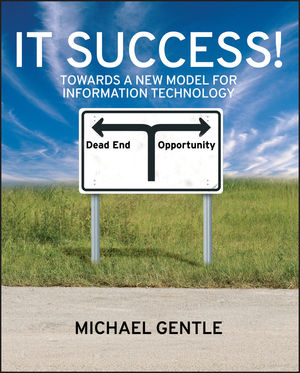IT Success!: Towards a New Model for Information TechnologyISBN: 978-0-470-72401-9
Paperback
192 pages
October 2007
 This is a Print-on-Demand title. It will be printed specifically to fill your order. Please allow an additional 10-15 days delivery time. The book is not returnable.
|
||||||
Introduction ix
Acknowledgements xiii
Abbreviations xvii
PART I BLINDED BY SPECS 1
1 In Search of the Fundamentals 3
The more things change, the more they stay the same 3
A worldwide phenomenon 4
How the traditional IT model started 5
The construction industry trap 6
The free lunch trap 7
Houses of ill repute 8
A business problem rather than an IT problem 10
IT and original sin 12
No sacred cows 12
2 IT 101 – The Basics for Non-Specialists 15
The process breakdown for traditional IT activities 15
The process breakdown for business (i.e. non-IT) activities 16
The fundamental difference between IT and non-IT activities 18
'That's not my problem!' – process ownership and behaviour 19
3 The Flaws of the Traditional Model 21
The unintended consequences of the waterfall method 21
In search of a pizza parlour manager 22
Who provides process expertise – client or vendor? 22
When standard client–vendor relationships are possible 24
When standard client–vendor relationships pose problems 25
Is a standard client–vendor relationship possible for IT? 26
The 'Statement of Requirements' (SoR) trap 26
A poor to non-existent pricing model 28
Should IT be run like a business (i.e. an ESP)? 30
The limits of outsourcing 31
Current IT organizational trends 32
The ultimate litmus test to determine one's business model 33
What model would be appropriate for IT? 34
PART II BUILDING A NEW BUSINESS MODEL FOR IT 35
4 Managing Demand 37
Managing demand – traditional model 37
Managing demand – new model 39
Capturing demand and identifying opportunities 41
Prioritizing and approving demand 43
Planning approved demand 49
Linking demand to resource capability 49
Approving demand based on portfolios 50
The missing component in Project Portfolio Management 53
Business cases are in the eye of the beholder 54
Building the IT plan and budget 55
Demand from a customer perspective 56
Shaking off the chains of the construction industry 56
Funding approved demand 58
Roles and responsibilities 59
5 Managing Supply 61
Managing supply - traditional model 61
Managing supply - new model 63
Iterative development in practice 65
Why prototyping has never become mainstream 74
Is prototyping the answer to everything? 78
Project critical success factors 79
Maintenance - letting go of the M-word 79
Delivery and implementation 81
Service and support 81
6 Monitoring Costs and Benefits 83
Monitoring costs and benefits for traditional IT activities 83
Monitoring costs and benefits for business (non-IT) activities 84
Monitoring costs and benefits – new model 85
Ownership and accountability for costs and benefits 86
Cost–benefit analysis during the life of a project 87
It is normal for costs and benefits to change! 88
Portfolio performance monitoring 88
Cost–benefit analysis after project delivery 89
7 Financials 91
The main categories of IT costs 91
Ownership of IT costs for the regulation of supply and demand 92
Who has the final say for IT investments? 92
Allocations vs cross-charging 93
Capturing costs for allocations and cross-charging 94
Benefits as part of the P&L and annual planning 95
Ongoing cost–benefit analysis for applications 96
Reducing application lifetime costs 100
The limits of financial ROI when applied to IT 102
PART III THE NEW MODEL IN PRACTICE 105
8 Players, Roles and Responsibilities 107
Players, roles and responsibilities – the business 107
Players, roles and responsibilities – IT 111
The new business–IT relationship 112
The changing role of the business analyst 113
The changing role of the developer 113
Towards the merging of the developer and analyst roles? 114
The changing role of the project manager 115
The changing role of the operations department 116
What role for PMOs? 117
The role of External Service Providers (ESPs) 119
9 Getting Started 121
The business challenge 121
The IT challenge 122
Where to start 123
How to start – from checklist to action plan 124
From the status quo to first results 128
From first results to asset management 133
The role of best-practice methodologies 136
How consulting companies can help 138
How tools can help 139
The costs of moving to the new model 140
In closing – addressing the three fundamental questions 142
Further reading 143
10 Case Study 145
The company 145
The business problem 146
The project context 146
Building an IT–business partnership 147
Kicking off the project 148
Feasibility study and defining a solution 149
Building the business case 150
Project approach 151
Product evaluation – buy or build decision 151
Building a prototype 152
Results 154
Timescales 155
Three months later 155
One year later 156
Two years later 156
Main lessons learnt (on the plus side) 156
Main lessons learnt (on the minus side) 157
Comments with respect to the new model 157
Reader feedback 158
Index 159



